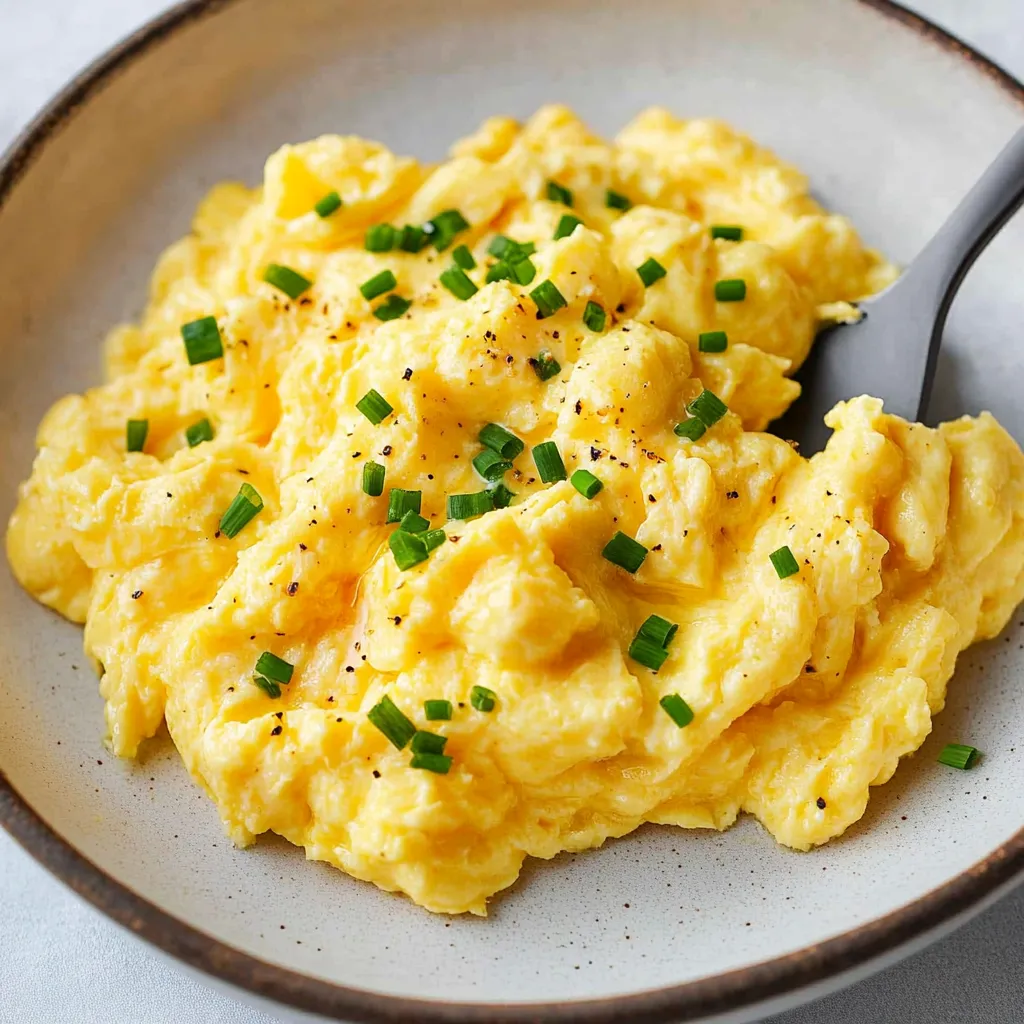 Pin it
Pin it
These scrambled eggs deliver restaurant-quality results using a simple technique that transforms basic ingredients into something genuinely luxurious and satisfying. Each forkful provides the perfect balance of creamy richness and delicate texture that makes ordinary mornings feel special, proving that mastering fundamental cooking techniques creates more impact than complicated recipes with exotic ingredients. They're the kind of simple pleasure that demonstrates how proper execution of basic skills can elevate everyday ingredients into something truly memorable.
I learned this technique after years of making rubbery, overcooked scrambled eggs that bore no resemblance to the silky, luxurious versions I enjoyed at good restaurants. The breakthrough came when I understood that scrambled eggs cook through residual heat and that patience creates the creamy texture I was seeking. Now this method is my go-to for weekend brunches and quick weekday breakfasts because it consistently produces results that feel indulgent while being completely achievable.
Essential Ingredients and Selection Tips
- Fresh, high-quality eggs: Choose the freshest eggs available, preferably from local sources or pasture-raised options for superior flavor and color
- Milk, plant milk, or water: Adds moisture for extra creaminess; use unsweetened almond milk for dairy-free option with neutral flavor
- Extra-virgin olive oil or butter: Provides fat for cooking and richness; olive oil offers clean flavor while butter adds indulgent taste
- Fine sea salt: Essential for enhancing natural egg flavor; add after cooking to prevent toughening
- Freshly ground black pepper: Adds depth and complexity; white pepper works for more subtle heat
Detailed Preparation Instructions
- Beat eggs to perfect consistency:
- Crack 6-8 fresh eggs into a medium bowl and whisk vigorously until yolks and whites are completely combined with no streaks or translucent areas visible. The mixture should be uniformly yellow and slightly frothy.
- Add moisture strategically:
- Whisk in 2-3 tablespoons of milk, plant milk, or water, incorporating thoroughly. This additional liquid creates steam during cooking that produces the signature creamy texture while preventing the eggs from becoming dense or rubbery.
- Prepare your cooking surface:
- Heat a small non-stick skillet over medium heat and brush lightly with extra-virgin olive oil or add a small pat of butter. The pan should be warm but not smoking - medium heat ensures gentle cooking that prevents overcooking.
- Start the cooking process carefully:
- Pour the egg mixture into the prepared pan and let it sit undisturbed for 10-15 seconds to begin setting. This initial rest allows the bottom layer to form structure before stirring begins.
- Create perfect curds:
- Using a rubber spatula, gently pull the cooked eggs from the edges toward the center, tilting the pan to allow uncooked egg to flow underneath. Work slowly and deliberately, scraping the bottom and sides to form large, soft curds.
- Control heat and timing:
- Reduce heat to medium-low and continue folding the eggs every 15-20 seconds, always scraping the bottom and sides of the pan. The eggs should cook gently and evenly without any browning or sizzling sounds.
- Stop at optimal doneness:
- Remove the pan from heat when eggs appear mostly set but still slightly wet and glossy. They will continue cooking from residual heat, reaching perfect creamy consistency off the burner.
- Season thoughtfully:
- Immediately season with fine sea salt and freshly ground black pepper to taste, folding gently to distribute. Serve immediately while still warm and creamy.
 Pin it
Pin it
The transformation happens through controlled heat application and understanding that eggs continue cooking after leaving the heat source. This residual cooking prevents overcooking while achieving the desired creamy texture.
The cooking vessel affects heat distribution and sticking. Non-stick pans provide easy release and even heating, while the size should accommodate your egg quantity without overcrowding, which leads to uneven cooking.
Temperature control determines final texture more than any other factor. Medium heat allows gentle cooking that develops creamy consistency, while high heat creates tough, rubbery eggs that lack the desired luxurious mouthfeel.
The fat choice impacts both flavor and cooking performance. Olive oil provides clean taste and high smoke point, while butter adds richness but requires careful heat management to prevent browning.
Serving and Storage
- Serve immediately for best texture and temperature - scrambled eggs don't hold well or reheat successfully
- Pair with toast, fresh fruit, or roasted vegetables for complete breakfast experience
- Consider texture preferences when timing - some prefer slightly wetter eggs while others like them more set
These scrambled eggs represent the perfect example of how mastering fundamental techniques creates extraordinary results from ordinary ingredients. They prove that exceptional cooking comes from understanding basic principles and executing them with care rather than relying on complicated recipes or exotic ingredients, making them both an achievable daily pleasure and an essential skill for any home cook.
Frequently Asked Questions
- → How long do scrambled eggs take to cook?
- Scrambled eggs cook in about 3 minutes on medium-low heat. The key is stirring gently and removing from heat while still creamy.
- → Should I add milk or water to scrambled eggs?
- Both work well. Milk makes eggs creamier while water makes them fluffier. Use about 1 teaspoon per 3 eggs.
- → What heat should I use for scrambled eggs?
- Start on medium heat, then reduce to medium-low. Low heat prevents the eggs from cooking too fast and becoming rubbery.
- → Why are my scrambled eggs watery?
- Watery eggs usually mean they're overcooked or the heat was too high. Remove from heat while still slightly wet - they'll finish cooking.
- → Can I make scrambled eggs without butter?
- Yes, you can use olive oil, cooking spray, or any cooking fat. Butter adds flavor but isn't required for good scrambled eggs.
- → How do I keep scrambled eggs from sticking?
- Use a non-stick pan and add a little fat (butter or oil) before cooking. Keep the heat at medium-low and stir gently.
